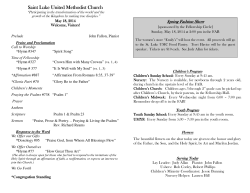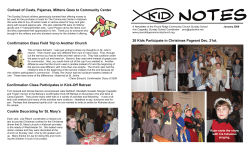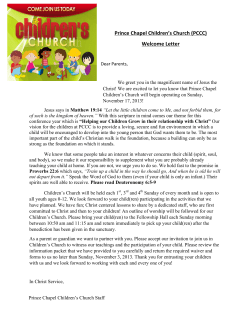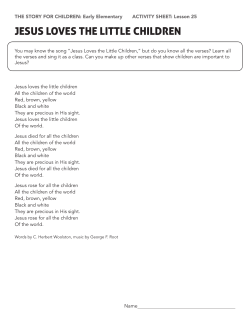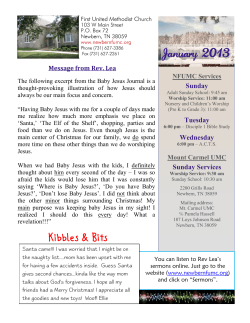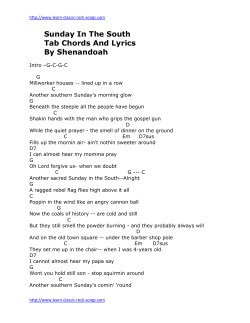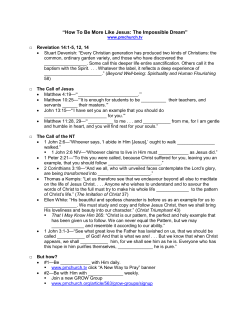
SBCAC Sunday School NEW TESTAMENT SURVEY I
SBCAC Sunday School NEW TESTAMENT SURVEY I I. Introduction A. Why Study the New Testament? 1. We get to know the Bible as a whole 2. We get to observe the theological themes of each book (Connecting the dots) 3. We get to see the authors original intent more clearly 4. We get to see exegesis and the minutia in its broader context 5. We get to emphasize Scripture over systems and presuppositions 6. We get to know Christ our Savior and His demands for the NT church B. What Will Be Covered? Matthew through Acts (Possibly more) Background, Purpose, Themes, Structure, Interpretive Issues, Application C. Personal Work and Resources 1. Chapter Summaries (and paragraph summaries). 2. Recurring Themes 3. Macarthur Study Bible Introductions D. Biblical Divisions 1. Canonicity The Old Testament The New Testament The Torah (Law) Historical The Prophets Epistolary The Writings Apocalyptic 2. OT = 78% of the Bible; NT = 22 % of the Bible. 1 SBCAC Sunday School E. New Testament Background 1. The Intertestamental Period The End of the Old Testament Timeline Malachi, Ezra/Nehemiah The Dominance of the Persian Empire (c. 538-332 BC). The Beginning of the 400 Years Over 400 years between the final events in the OT(Ne 13:4-30; Mal 1:1-4:6) and the beginning of the NT (Lk 1:5-25). No prophetic word from God (400 Years of Silence). The Events The Hellenistic Period [Alexander the Great] (332-142 BC) The Ptolemies of Egypt [Ptolemy I] (320-198 BC) The Seleucids of Syria [Seleucus I] (198-142 BC) Antiochus IV Epiphanes (175-164 BC) The Maccabean/Hasmonean Period (166-63 BC) The Roman Period (63 BC onward) Pompey, Aristobolus II and Hyracanus II Antipater and his sons (63-37 BC) Herod the Great [Son of Antipater] (37-4 BC) Herod’s Sons and Grandson [Herod Agrippa] (4 BC – 44 AD) Herod Archelaus (Judea and Samaria) 2 SBCAC Sunday School Herod Antipas (Galilee and Perea) Herod Philip (Northern Palestine) Herod Agrippa Key Connections to Christ Developing Places and Parties Diaspora Synagogue Temple Scribes and Rabbis Pharisees Sadducees Essenes Zealots 2. The Sources for Background Information on the New Testament Septuagint [LXX] (c. 250-125 BC): translation of the Hebrew OT Greek Apocrypha and Pseudepigrapha: Jewish writings from 200 BC – 100 AD. The Dead Sea Scrolls Philo: Jewish Philospher Josephus: Jewish Historian The Mishnah The Targums 3 SBCAC Sunday School II. Introduction to the Gospels The term Gospel comes from the Greek word euangellion which means “good news.” The four Gospel accounts are the record of the life, death, and resurrection of Jesus Christ. And they are ultimately didactic. A. Are Multiple Accounts Wrong? B. General Information 1. Relationship Gospel1 Date Audience Purpose MATTHEW AD 40-50 Jewish Didactic MARK AD 64-68 Gentile Evangelistic 2. Genre Historical Memoirs Biographical (not complete) Gospel oriented 3. Distribution of the New Testament History (Matthew – Acts) = 60% Letters (Pauline and NonPauline) = 34% Prophecy (Revelation) = 6% 1 From Dr. Keith Essex (The Master’s Seminary) 4 LUKE AD 58-60 Gentile Didactic JOHN AD 80-90 Jewish Evangelistic SBCAC Sunday School C. The Synoptic “Problem” The term “Synoptic” comes from the Greek word sunoptikos (“syn” – together, “optic” – seeing. It means to see things together) and it refers to similar Gospel accounts of Matthew, Mark, and Luke. It is a discussion on whether Matthew, Mark, and Luke wrote their Gospels through independent writing, by borrowing from each other, or by looking at other sources. 1. Different Theories There are many theories that attempt to explain the relationship of the synoptic Gospels. One of those theories is the “Two-Document (Source) Theory.” Since so much material in Mark is found in Matthew and Luke, this theory states that Mark must have been written first so Matthew and Luke used the material in Mark. To explain the material not found in Mark (but found in Matthew and Luke), some say they drew upon another Gospel account called “Q” (for the German word quelle, which means “source”). 2. Modern Criticisms In an attempt to address the apparent contradictions, different studies were invented. Historical Criticism: When scholars attempt to discover “what actually happened” in history when there seems to be apparent contradiction. Source Criticism: Attempts to identify the same sources used to write the synoptic Gospels. Form Criticism: It accepts Source Criticism but tries to figure out how the Gospel writers collected and “edited” the information. Redaction Criticism: The writer edited the historical information in order to fit his theological viewpoint. This study seeks to differentiate between the viewpoint from the original source materials. 5 SBCAC Sunday School 3. The Response Evidence Against the Two-Document theory [MSB, 1421-22] Until the 19th Century, the unanimous testimony of the church was that Matthew was the first Gospel written. Matthew, an eyewitness, would not depend on Mark (not an eyewitness) for the events of Christ (including Matthew’s own conversion). The many differences between the synoptic Gospels argue against dependence. If they were more verbatim, then it would be plausible. The sequence of historical events does not mean that they used each other for information (Example: Books that contain Civil War, WWI, WWII, etc.) There are passages in Matthew and Luke that don’t “agree” with Mark. This is 1/6 of both Matthew and Luke. There is no reason why Matthew and Luke would change Mark’s wording like this. The theory cannot account for Luke’s omission of Mark 6:45-8:26. It suggests that Luke did not see Mark’s Gospel. No historical or manuscript evidence that the Q document ever existed. These Gospel writers could have had many encounters with each other. In conclusion, there is no synoptic problem. Principles for Harmonizing the Gospels (Handout) 6 SBCAC Sunday School III. Matthew A. Introduction 1. Title: “According to Matthew” 2. Author: Matthew Oral tradition Personal Reference: “Matthew” versus “Levi” (9:9; 10:3; cf. Mark 3:18; Luke 6:15). 3. Audience: Jewish (Christians?) Matthew contains Jewish vocabulary Jewish Genealogy 4. Occasion and Date (AD 40-50) B. Purpose The purpose was to show that Jesus was the promised Messiah and what He demands of His Kingdom dwellers. C. Book Structure 1. Literary Structure Outline I. Introduction: The King Has Come (Chaps 1-2) II. The Ministry of the King (3:1-26:2) A. The Introduction of the King (Chaps 3-7) 1) Narrative 1: The Authentication of the King (Chaps 3-4) 2) Discourse 1: The Sermon on the Mount: The Present righteousness of Future Kingdom Dwellers (Chaps 5-7) 7 SBCAC Sunday School B. The Manifestation of the King (8:1 – 11:1) 1) Narrative 2: The Power of the King (8:1-10:4) 2) Discourse 2: Instructions to the Disciples of the King (10:5-11:1) C. The Opposition to the King (11:2-13:53) 1) Narrative 3: The Great Rejection of the King (11:2-12:50) 2) Discourse 3: The Parables of the Kingdom: A revelation of the course of events that will take place until the Kingdom is established (13:1-52) D. The Withdrawal of the King (13:53-18:35) 1) Narrative 4: The Continued Rejection the King (13:53-17:27) 2) Discourse 4: The Greatest in the Kingdom (Chapter 18) E. The King’s Rejection of Israel (Chaps 19-25) 1) Narrative 5: Nation Rejects King; King Rejects Nation (19:1-23:39) 2) Discourse 5: The Olivet Discourse: The Return of the King and His Establishment of the Kingdom (Chaps 24-25) III. The Death and Resurrection of the King (Chaps 26-28) 2. Walkthrough (Unit-by-Unit Discussion) 8 SBCAC Sunday School D. Themes 1. God [48x]: The Father [43x], Son [11x], Holy Spirit [12x] 2. The Kingdom (2:2; 3:2; 4:23; 12:28;) 3. The Old Testament Terms like “Be fulfilled” (1:22), “written” (2:5), “Scriptures” (21:42), or “The Law” (5:17), are seen throughout. 4. Discipleship (10) 5. True Righteousness (5:6) 6. The End Times (24-25) E. Interpretive Issues 1. The Kingdom 2. The Sermon on the Mount (5-7) 3. The Unpardonable Sin (12:22-37) 4. The “Rock” (16:18) 5. Church Discipline (18:15-20) 6. The Olivet Discourse (24-25) 9 SBCAC Sunday School IV. Mark A. Introduction 1. Title: “According to Mark” 2. Author: John Mark the Disciple of Peter. 3. Audience: Gentiles (Specifically, Romans) 4. Occasion and Date: AD 65-68 B. Purpose Since Jesus is the Servant-Messiah and Son of God, He must be followed. C. Book Structure 1. Literary Structure Outline I. Prologue: Jesus’ Introduction (1:1-13) II. Jesus Put on Display (1:14-15:41) A. Ministry in Galilee: Jesus is the Messiah (1:14-8:30) 1. Ministry Begins: An Intro to His Authority (1:14-3:6) 2. Ministry Climaxes: The Extent of His Authority (3:7-6:13) 3. Ministry Grows: His Disciples Recognize His Authority (6:14-8:30) B. Ministry in Jerusalem: Jesus is the Son of God (8:31-15:41) 1. Going to Jerusalem: Teaching and Predicting (8:31-10:52) 2. Going to the Temple: Interacting and Demonstrating (11:1-13:37) 3. Going to the Cross: Suffering and Dying (14:1-15:41) III. Epilogue: Jesus’ Resurrection (15:42-16:8[20]) 2. Walkthrough 10 SBCAC Sunday School D. Themes 1. God (Father, Jesus, Christ, Son of God, The Son of Man, The Holy Spirit) 2. The Gospel (1:1, 14, 15) 3. Satan’s Power (Unclean Spirits, Demons – 1:13, 23, 34) 4. Opposition to Jesus’ Authority (Chaps 1-15) 5. Miracles (Chaps 1-8) 6. Discipleship (1:2, 18; 4:40; Chaps 1-16). E. Interpretive Issues 1. The Ending of Mark (Chapter 16) Further study: Macarthur Study Bible; Shepherds’ Conference 2012: http://www.shepherdsconference.org/media/details/?mediaID=6788 11 SBCAC Sunday School V. Luke/Acts Luke and Acts must be interpreted together Author: Someone close to Paul (Use of “We” 16:10-17; 20:5-21:18; 27:128:16) Recipient: Theophilus (Luke 1:3; Acts 1:1) Purpose: It was written so that Gentile Christians would be certain that the Word of God was true. Date: AD 58-63 VI. Luke A. Introduction 1. Title: “According to Luke” 2. Author: Luke Col 4:14; 2 Tim 4:11; Philemon 24 Medical language (14:2) 3. Audience: Theophilus (1:3; Acts 23:26; 24:3; 26:25) 4. Occasion and Date (AD 58-60) B. Purpose The purpose was to show and be certain that the God-man, Jesus, was the Lord and Savior for the believers. 12 SBCAC Sunday School C. Book Structure 1. Literary Structure Outline I. Preface (Introduction) [1:1-4] II. The Opening: Jesus and John the Baptist in the Early Years (Chs. 1-2) III. Public Ministry: The Works and Words of Christ (Chs. 3-21) A. The Preparation: Getting Ready for Ministry (3:1-4:13) B. The Revealing: Christ in Galilee (4:14-9:50) C. The Words: Jesus Going to Jerusalem and Addressing His Denial (9:51-19:27) D. The Rejection: Jesus in Jerusalem Prophesying and Being Rejected (19:28-21:38) IV. The Epilogue: Death, Resurrection, and Ascension (Chs. 22-24). 2. Walkthrough 13 SBCAC Sunday School D. Themes 1. Parables Unique to Luke (7:41-43) 2. The Holy Spirit (1:15) 3. Angels (1:11). 4. History (1:5) 5. God’s Inclusion of Gentiles (2:29-32; 13:22-30) E. Interpretive Issues 1. “In the _____ of my Father” (2:49) 2. “The Kingdom of God is within you” (17:21) VII. John A. Introduction 1. Title: “According to John” 2. Author: John The Disciple Whom Jesus Loved (21:20, 24) A part of the Twelve (13:23), Guardian of Mary (19:26-27), Saw the Empty Tomb (20:2-8), Fisherman (21:7) 3. Audience: Unbelievers (Jewish?) 4. Occasion and Date (AD 90) B. Purpose The purpose was to show that believing in Jesus the Son of God brings life. 14 SBCAC Sunday School C. Book Structure 1. Literary Structure 2. Outline I. Intro: The Word Became Flesh (1:1-18) II. The Signs of the Son of God (1:19-20:31) A. The Public Revelation of the Son (1:19-12:50) 1) The Starting Signs (chaps. 1:19-4:45) 2) The Snubbing of the Signs (chaps. 5-12) B. The Personal Revelation of the Son (13:1-20:29) 1) The Preparation (chaps. 13-17) 2) The Exaltation: the Death and Resurrection (chaps. 18-20:29) C. The Purpose of the Son (20:30-31) III. The Sending of the Son of God (21:1-25) 3. Walkthrough 15 SBCAC Sunday School D. Themes 1. Signs (Used 17 times: 2:11; 20:30) 2. Jesus as the Son of God (1:34, 49; 6:40; 8:36; 20:31) 3. Belief and Faith (Used 98 times: 2:22; 3:12; 11:27) 4. Life (Used 53 times: 3:15; 17:2, 3) 5. The World (Used 78 times: 1:9-10; 13:1) E. Interpretive Issues 1. The Water (3:5) 2. “Receive the Holy Spirit” (20:22) 3. Christ and Peter (21:15-17) VIII. Acts A. Introduction 1. Title: “Acts” 2. Author: Luke 3. Recipient: Theophilus 4. Occasion and Date (AD 62) B. Purpose Acts was written to show the spreading of the Word through the apostles to the ends of the earth, to both Jews and Gentiles. 16 SBCAC Sunday School C. Book Structure 1. Literary Structure Outline I. The Preface (1:1-2) II. The Witness to Israel (1:3-12:25) A. The Word Spreads through Jerusalem (1:3-6:7) B. The Word is Spread by a New Apostle (6:8-9:31) C. The Words is Spread by Peter’s Ministry (9:32-12:25) III. The Witness to the Gentiles (Chaps 13-28) A. Paul Goes to the Gentiles (13-16:5) B. Paul Goes to Other Gentiles Locations (16:6-19:20) C. Paul Goes to Rome (19:21-28:31) 2. Walkthrough 17 SBCAC Sunday School D. Themes 1. God’s Sovereign Plan 2. The Preaching of the Word 3. Israel’s Rejection of the Word (13:46) 4. The Gentile Reception of the Word (11:18) 5. The Beginnings of the Church (Ch. 2) 6. The Obedience of God’s People E. Interpretive Issues 1. The “Speeches/Sermons” in Acts 2. The Use of and Interpretation of OT Passages (Peter, James, etc.) 18
© Copyright 2025

